A Better Sense of Place
2014 October 25 (Sat)
Exotics that I haven't killed yet
I've planted and left alone species fairly native to my parish and I've pulled up many an exotic from the ground, but there are still many larger individuals in the yard that are definitely not from 'round these parts. I thought it'd be a good exercise to write about them and why I haven't killed them yet. I also list alternatives that I would plant instead (and which are not necessarily what native appears the most similar).
Abelia
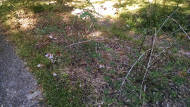 In alphabetical order by common name, abelia comes first. Really, it's glossy abelia (Abelia × grandiflora). I bought four of these for the yard from Arbor Day Foundation back when I didn't think too much about what's native. They are just about 3 years old now.
In alphabetical order by common name, abelia comes first. Really, it's glossy abelia (Abelia × grandiflora). I bought four of these for the yard from Arbor Day Foundation back when I didn't think too much about what's native. They are just about 3 years old now.
- Pros
- They produce flowers throughout the hot summer.
- Don't mind heat and full sun.
- Bees seem to somewhat feed on them.
- Cons
- Bees checked out the flowers but didn't really go nuts over them.
- I don't think it's a host plant for anything.
- No fruit
- Still around because: They haven't reached full size yet, so I don't know if they are pretty enough to overcome the fact they are exotic. And I paid good money for them.
- Alternatives
- fetterbush
- spicebush
- sweet pepperbush
- buttonbush
Azalea
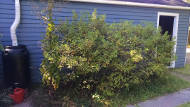 Next is the azalea (Rhododendron sp?). There are two large ones by the garage that have light pink flowers and two stubby ones that have dark red flowers. They came with the house.
Next is the azalea (Rhododendron sp?). There are two large ones by the garage that have light pink flowers and two stubby ones that have dark red flowers. They came with the house.
- Pros
- Flowers look pretty
- Evergreen
- Hardy
- Cons
- Flowers only last a week
- Host plant for nothing
- Completely uninteresting for 51 weeks of the year
- Still around because: They are huge and would take a lot of digging to remove. There's also something stupidly nostalgic about them because I grew up with azaleas
- Alternatives
- Native azaleas
- red chokeberry
- inkberry
- coralbean
- American beautyberry
- wax myrtle
Camphor trees
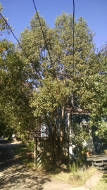 On to the camphor trees (Cinnamomum camphora). The main tree in question is growing on the southwest corner of the house.
On to the camphor trees (Cinnamomum camphora). The main tree in question is growing on the southwest corner of the house.
- Pros
- Robins and cedar waxwings eat the fruit in winter
- It provides afternoon shade to the house
- Cons
- Seedlings sprout everywhere
- Nothing grows well under them
- Still around because: If cut down, the hot afternoon sun would hammer the house. There's also not a whole lot of tall, narrow, and fast-growing native trees that could fit right there.
- Alternatives
- baldcypress
- Eastern hop-hornbeam? (Ostrya virginiana)
- yaupon?
- black cherry?
Crepe myrtle
 No list of exotics for Baton Rouge is complete without a crepe myrtle (Lagerstroemia sp?). There are two in the yard, one giant one as a street tree and one in the backyard.
No list of exotics for Baton Rouge is complete without a crepe myrtle (Lagerstroemia sp?). There are two in the yard, one giant one as a street tree and one in the backyard.
- Pros
- They have pretty bark.
- The front yard tree is huge.
- They do act as nectar plants to something, I read recently.
- Their leaves turn orange and red in the fall.
- The one in the front protects the yard from errant cars (as it did a month or two ago).
- Cons
- They can't withstand the heat and drop most of their leaves in late summer.
- They sucker from their roots.
- Other than their bark (and size), they're otherwise ugly.
- Still around because: The giant one in the front is pretty impressive. The one in the back... I guess I'm just not looking forward to sawing it down and having to start from scratch with a short tree.
- Alternatives
- blackgum (for front yard)
- sparkleberry or green hawthorn (for back)
Nandina
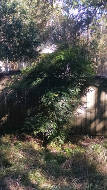 Then there's nandina (Nandina domestica). It's in the Chicken Yard and taller than the fence.
Then there's nandina (Nandina domestica). It's in the Chicken Yard and taller than the fence.
- Pros
- Mockingbirds nested in it this year.
- Bushy and full
- Cons
- Now recognized to be toxic to birds.
- Still around because: I haven't gotten replacement plants yet. Still, it may not live to see the spring.
- Alternatives
- red mulberry
Sago palm
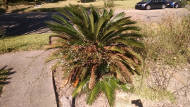 The final species I want to look down on is the sago (Cycas revoluta). There are four in the front yard.
The final species I want to look down on is the sago (Cycas revoluta). There are four in the front yard.
- Pros
- The thick, dark leaves are interesting.
- Cons
- -
- [Update: they are toxic to dogs.]
- Still around because: I'd feel bad about killing such old plants. And they're not hurting anyone. Except when they poke me.
- Alternatives
- Adam's needle (by sidewalk)


